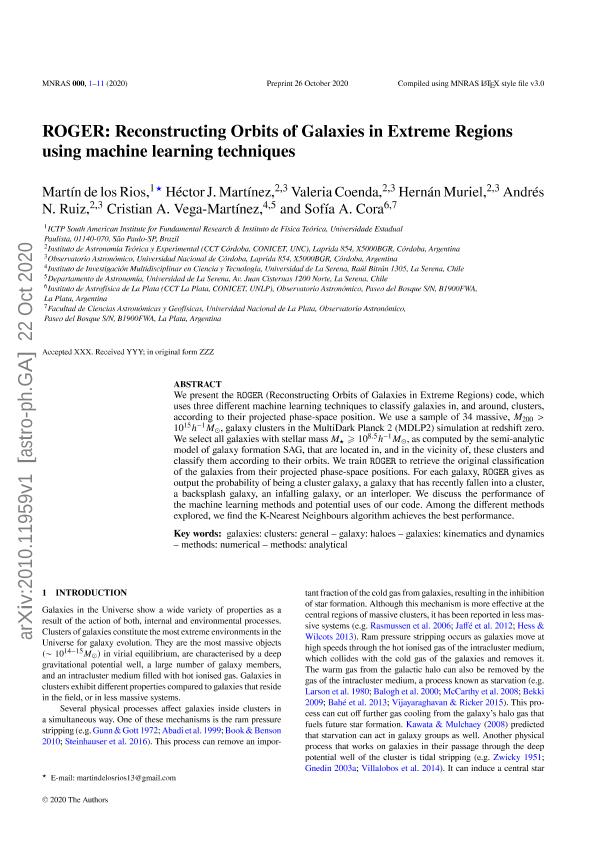Artículo
ROGER: Reconstructing orbits of galaxies in extreme regions using machine learning techniques
de Los Rios, Martín Emilio ; Martínez, Héctor J.; Coenda, Valeria
; Martínez, Héctor J.; Coenda, Valeria ; Muriel, Hernan
; Muriel, Hernan ; Ruiz, Andrés Nicolás
; Ruiz, Andrés Nicolás ; Vega Martínez, Cristian Antonio
; Vega Martínez, Cristian Antonio ; Cora, Sofia Alejandra
; Cora, Sofia Alejandra
 ; Martínez, Héctor J.; Coenda, Valeria
; Martínez, Héctor J.; Coenda, Valeria ; Muriel, Hernan
; Muriel, Hernan ; Ruiz, Andrés Nicolás
; Ruiz, Andrés Nicolás ; Vega Martínez, Cristian Antonio
; Vega Martínez, Cristian Antonio ; Cora, Sofia Alejandra
; Cora, Sofia Alejandra
Fecha de publicación:
01/2020
Editorial:
Wiley Blackwell Publishing, Inc
Revista:
Monthly Notices of the Royal Astronomical Society
ISSN:
0035-8711
e-ISSN:
1365-2966
Idioma:
Inglés
Tipo de recurso:
Artículo publicado
Clasificación temática:
Resumen
We present the ROGER (Reconstructing Orbits of Galaxies in Extreme Regions) code, which uses three different machine learning techniques to classify galaxies in, and around, clusters, according to their projected phase-space position. We use a sample of 34 massive, M200 > 1015h-1M⊙, galaxy clusters in the MultiDark Planck 2 (MDLP2) simulation at redshift zero. We select all galaxies with stellar mass M∗ ≥ 108.5h-1M⊙, as computed by the semi-analytic model of galaxy formation SAG, that are located in, and in the vicinity of, these clusters and classify them according to their orbits. We train ROGER to retrieve the original classification of the galaxies from their projected phase-space positions. For each galaxy, ROGER gives as output the probability of being a cluster galaxy, a galaxy that has recently fallen into a cluster, a backsplash galaxy, an infalling galaxy, or an interloper. We discuss the performance of the machine learning methods and potential uses of our code. Among the different methods explored, we find the K-Nearest Neighbours algorithm achieves the best performance.
Archivos asociados
Licencia
Identificadores
Colecciones
Articulos(IATE)
Articulos de INST.DE ASTRONOMIA TEORICA Y EXPERIMENTAL
Articulos de INST.DE ASTRONOMIA TEORICA Y EXPERIMENTAL
Citación
de Los Rios, Martín Emilio; Martínez, Héctor J.; Coenda, Valeria; Muriel, Hernan; Ruiz, Andrés Nicolás; et al.; ROGER: Reconstructing orbits of galaxies in extreme regions using machine learning techniques; Wiley Blackwell Publishing, Inc; Monthly Notices of the Royal Astronomical Society; 500; 2; 1-2020; 1784-1794
Compartir
Altmétricas



